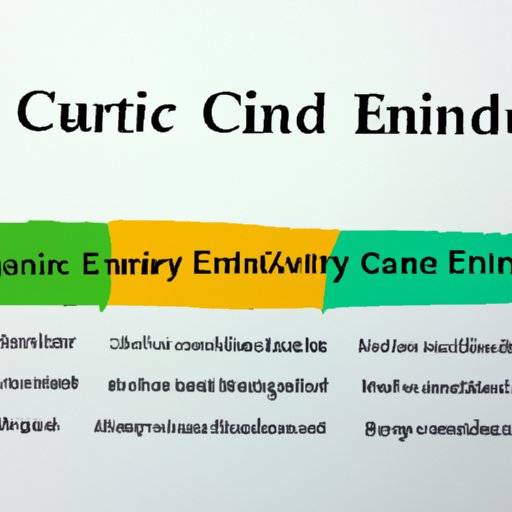Introduction
An equity line of credit (ELOC) is a type of loan that allows you to borrow against the equity in your home. It is a revolving line of credit, meaning you can borrow up to a predetermined limit, and then repay the money and borrow against it again if needed. Equity lines of credit are typically used for large purchases, such as home improvement projects or medical bills, and offer a number of advantages over other types of financing.

Comparing an Equity Line of Credit to Other Types of Financing
Before looking at how an equity line of credit works, it’s important to understand how it compares to other types of financing. According to a study by the Federal Reserve Bank of Philadelphia, “A home equity loan provides a lump-sum payment of funds borrowed against the equity of the borrower’s house. A home equity line of credit is a revolving line of credit secured by a borrower’s home.”
Advantages of an Equity Line of Credit
One of the primary advantages of an equity line of credit is the flexibility it offers. Unlike a traditional loan, you don’t have to borrow the full amount of the loan all at once. You can draw from the line of credit as needed and only pay interest on the amount you borrow. In addition, the interest rate on an equity line of credit is typically lower than other types of financing, making it an attractive option for those who need access to funds quickly.
Disadvantages of an Equity Line of Credit
The main disadvantage of an equity line of credit is the risk involved. If you default on the loan, you could lose your home. Additionally, there may be other fees associated with the loan, such as origination fees or closing costs. Finally, the interest rate on an equity line of credit is typically variable, meaning it can go up or down depending on market conditions.

Describing the Process of Applying for an Equity Line of Credit
Once you’ve decided that an equity line of credit is right for you, the next step is to apply. The qualifications required for an equity line of credit vary from lender to lender, but generally speaking, you must have at least 20% equity in your home, a good credit score, and sufficient income to make the payments.
Qualifications Required
In order to qualify for an equity line of credit, lenders will typically require you to have at least 20% equity in your home. This means that you must own at least 20% of the value of your home. In addition, lenders will typically look at your credit score and debt-to-income ratio to determine if you are a good candidate for an equity line of credit.
Application Process
Once you meet the qualifications, the application process is relatively straightforward. You will need to fill out an application and provide proof of income and assets. The lender will then review the application and, if approved, provide you with a line of credit. Once approved, you can begin using the line of credit as needed.
Examining the Costs Associated with an Equity Line of Credit
When considering an equity line of credit, it’s important to understand the costs associated with it. There are two main costs to consider: interest rates and fees.
Interest Rates
The interest rate on an equity line of credit is typically variable, meaning it can go up or down depending on market conditions. However, most lenders offer competitive rates, so it’s important to shop around and compare rates before signing up for a loan.
Fees
In addition to interest rates, there may also be other fees associated with an equity line of credit. These include origination fees, annual fees, and closing costs. Make sure to ask about all fees before signing up for a loan.
Discussing How to Use an Equity Line of Credit Responsibly
It’s important to use an equity line of credit responsibly in order to maximize its benefits and minimize its risks. Here are some tips for using an equity line of credit responsibly:
Making Sure You Have Enough Equity
First, make sure you have enough equity in your home to cover the loan. If you don’t have enough equity, you may end up owing more than the value of your home, which could put you in a difficult financial situation.
Keeping Your Debt-to-Income Ratio Low
Second, make sure to keep your debt-to-income ratio low. This is the ratio of your total monthly debt payments to your gross monthly income. Lenders typically want to see a debt-to-income ratio of 36% or less, so make sure to keep your debt-to-income ratio in check.

Highlighting Tips for Maximizing the Benefits of an Equity Line of Credit
Finally, here are some tips for maximizing the benefits of an equity line of credit:
Shopping Around for the Best Rates
Shop around for the best rates. Different lenders offer different rates, so make sure to compare rates before signing up for a loan.
Paying Off the Balance Quickly
Pay off the balance quickly. Interest rates on an equity line of credit are typically variable, so try to pay off the balance quickly to avoid higher interest rates in the future.
Conclusion
An equity line of credit is a type of loan that allows you to borrow against the equity of your home. It can be a great way to access funds quickly, but it’s important to understand the risks and costs associated with it. Be sure to shop around for the best rates, keep your debt-to-income ratio low, and pay off the balance quickly to maximize the benefits of an equity line of credit.
(Note: Is this article not meeting your expectations? Do you have knowledge or insights to share? Unlock new opportunities and expand your reach by joining our authors team. Click Registration to join us and share your expertise with our readers.)
